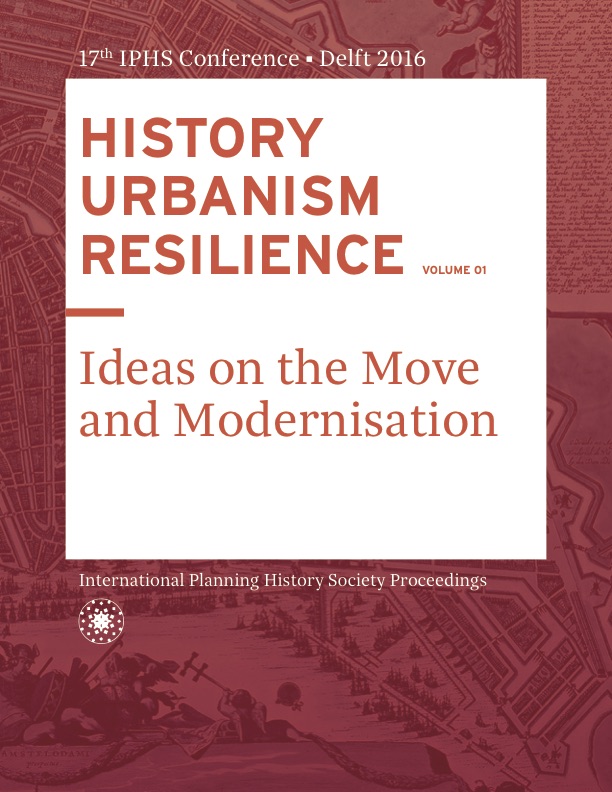The work of the Japanese Specialists for New Khmer Architecture in Cambodia
DOI:
https://doi.org/10.7480/iphs.2016.1.1203Abstract
Cross cultural exchanges are an important aspect in the development of modern architecture. Multiple flows of ideas have shaped the architecture of Cambodia in the second half of the 20th century. Western designers shaped Cambodia’s architectural and urban form, but the country also saw collaboration from Japanese practitioners and this paper explores their respective roles and paradigms. Helen Grant Ross and Darryl Leon Collins, for example, regarded the 1960s as the age of New Khmer Architecture in Cambodia. They have explored the French-educated architect young Cambodian leader Vann Molyvann, who led this age as an architect-administrative official. However the fact that there were some Japanese architects who collaborated on some of these projects is not well known. In particular, Gyoji Banshoya (1930-1998) and Nobuo Goto (1938-2000), two students of the Japanese leading architect Kiyoshi Seike, officially participated in projects during the 1960s and wrote plans, reports and articles.Based on new resources found in the private libraries of the Japanese planners, this paper discusses Modern Khmer Architecture based on the largely unknown fact that some Japanese architects participated in projects in Cambodia. The question of how to manage the modernization of historical spatial composition of cities was a common interest shared by the French, the Japanese and the Cambodians alike. This paper explores the international context of building in Cambodia including the movements of CIAM members, including the French planner Gerald Hanning, the participation of Banshoya, and the supervision by Vann Molyvann. It specifically explores how the Japanese architects, Banshoya and Goto, contributed to the projects in Cambodia in the 1960s, the age of Modern Khmer Architecture. Banshoya participated in huge projects such as the stadium, collective houses and master plans. Goto also supported the work of Banshoya. He investigated his own interests and found his own way with his experimental habitat. What is important is that these French-influenced Japanese architects cherished the historical composition of Asian or local space and incorporated it in their modern planning policy. A specific example is Banshoya’s first piece “the Square House” which was a low cost house which harmonized Japanese tradition and modernism. His work in Algiers titled “Temporary Housing Replacing Tin-Roofed Shelters” adopted the traditional housing plan with patio supporting the separation of public and private spaces. In Cambodia, under the supervision of Banshoya, the more senior Goto tried to reconstitute the spatial composition of the traditional Khmer house and suggested plans for modern Khmer house and housing areas.
Banshoya completed his mission in the ancient French protectorate of Cambodia and his projects were also related to some of the heritage of CIAM. Banshoya’s mission in Cambodia was limited to 1 year, but it was significant as his first assignment as a UNDP specialist. He continued as a UNDP specialist untill the 1970s when he elaborated the master plan of Aleppo. This paper focuses on the cross-cultural investigation of the Cambodian projects and therewith lays the foundation for new analytical perspectives of the master plans in Beirut, Damascus and Aleppo.
References
Anon. Anlong Romeat Village Type Existant Façades Est des gropupes 1, 2 & 4. Direction de l’Urbanisme et de l’Habitat, sirca 1962.
Bodiansky,Vladimir. “Collaboration Architecte-Ingenieur”, Techniques & Architecture, 25, vol.4 (1965) : 122-124.
Goto, Nobuo. Kompong Som Cité Portuaire Zones Mixte et Administrative. Ministère des Travaux Publiques du Cambodge, 1962.
Goto, Nobuo. Palais des Sports, Royaume du Cambodge, Ministère des Travaux Publiques, Agence des Opérations, 1962.
Goto, Nobuo. Layout Plan, sirca 1973.
Hanning, Gerald, Nobuo Goto et Setsuo Okada, “Réadapter l’Autoconstruction Tentative Cambodgienne (1963)”, L’Architecture d’Aujourd’hui, 167(1973) : 20-22.
Julien Mingui, “Front du Bassac: histoire triste d’un grand immeuble blanc,” In Phnom Penh à l’aube du XXIe siècle, 62-65. Phnom Penh :Atelier Parisien d’Urbanisme, 2003.
Lemarchands, Guy. “Phnom Penh: Capitale de l’Etat indépendant du Cambodge” In Phnom Pemh, Développement urbain et patrimoine, 44-49. Paris : Atelier parisien d’urbanisme, 1997.
Lisa Ros, “Logements du « front Bassac » ou cité Sihanouk,” In Phnom Penh à l’aube du XXIe siècle, 66-69. Phnom Penh : Atelier Parisien d’Urbanisme, 2003.
Matsubara, Kosuke. “Japanese Cooperation for Evolutional Housing and Slum Upgrading Projects under Mayor Chevallier : Spatial Experience of Gyoji Banshoya in Algiers”, In Sustainable North African Society : Exploring Seeds and Resources for Innovation, edited by Hiroko Isoda, Marcos Neves, and Atsushi Kawachi, 267-284. New York : Nova Science Publishers, 2015.
Molyvann, Vann, Vladimir Bodiansky, et Gérald Hanning. “Forum de la ville de Phnom-Penh, Cambodge”, Cahiers du Centre Scientifique et Technique du Batiment, 73(1964) :1-16.
Molyvann, Vann, Vladimir Bodiansky. “Complexe Olympique de Pnom-Penh”, L’Architecture d’Aujourd’hui, 116(1964) : 30-33.
Molyvann, Vann, Vladimir Bodiansky. “Cambodge Complexe Olympique et Forum de Phnom Penh”, Techniques & Architecture, 25(1965) : 9-15.
Molyvann, Vann. “A l’école des maîtres angkoriens”, Nokor Khmer, 1, octobre-décembre, 1969.
Molyvann, Vann. Les Cités Khmères Modernes. Phnom Penh : Reyum, 2003.
Ross, Helen Grant, and Collins Leon Darryl, Building Cambodia: ‘New Khmer Architecture’ 1953-1970, Bangkok: The Key Publisher Co. Ltd., 2006.
Sangkum Reastr Niyum, Photos-Souvenirs du Cambodge Urbanisme et Tourisme, 6(1970).

